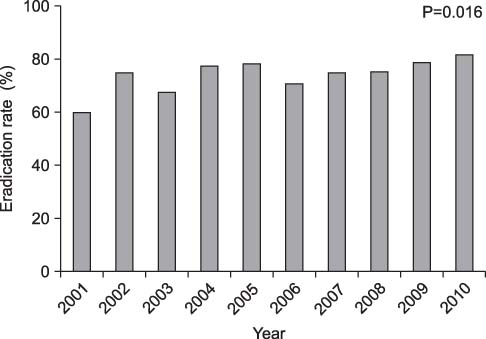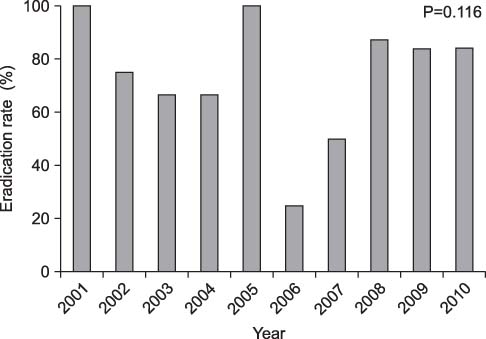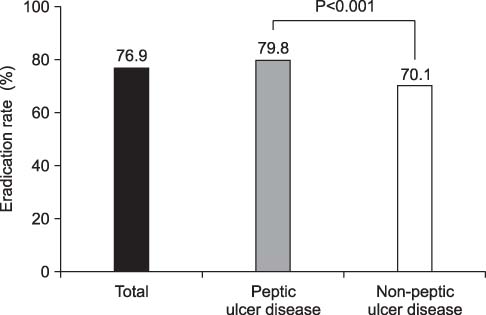Ewha Med J.
2014 Mar;37(1):26-29. 10.12771/emj.2014.37.1.26.
The Trend of First-Line and Second-Line Eradication Rates for Helicobacter pylori Infection in a Single Institute in Seoul
- Affiliations
-
- 1Department of Internal Medicine, Ewha Womans University School of Medicine, Seoul, Korea. shimkn@ewha.ac.kr
- KMID: 2171270
- DOI: http://doi.org/10.12771/emj.2014.37.1.26
Abstract
OBJECTIVES
To investigate the rate of first-line eradication and the rate of second-line eradication of Helicobacter pylori (H. pylori) from 2001 to 2010 in a single institute in Seoul.
METHODS
Among the 2,717 patients who received H. pylori eradication treatment from 2001 to 2010 at Ewha Womans University Mokdong Hospital, the medical records of 1,466 patients who satisfied the condition of execution of upper gastrointestinal endoscopy, positive H. pylori eradication results at 6~8 weeks after eradication therapy were reviewed retrospectively. Then the first-line and second-line eradication rates and the eradication rates according to endoscopy findings were also compared.
RESULTS
The first-line eradication rate was 77% H. pylori eradication rate for the last 5 years was continuously increasing and no sign of decline was observed even for the whole 10 years. The rates of eradication related to endoscopic findings showed statistical significance (P<0.001) of 79.8% and 70.1% each for peptic ulcer and non-ulcerative gastric diseases, respectively.
CONCLUSION
In this study, no decrease in tendency of first-line eradication rate could be found. In addition, the patients with the non-ulcerative gastric disease seemed to show significantly lower eradication rate. This finding suggests eradication treatment may be affected by the category of gastric diseases, and careful considerations should be taken assessing the effects and needs for the H. pylori eradication treatment.
Keyword
MeSH Terms
Figure
Reference
-
1. Seol SY. Treatment of Helicobacter pylori infection. Korean J Med. 2006; 70:349–351.2. Song HJ, Jung HC. Retreatment strategy of Hellcobacter pylori infection after initial treatment failure. Korean J Med. 2003; 65:272–276.3. Rokkas T, Sechopoulos P, Robotis I, Margantinis G, Pistiolas D. Cumulative H. pylori eradication rates in clinical practice by adopting first and second-line regimens proposed by the Maastricht III consensus and a third-line empirical regimen. Am J Gastroenterol. 2009; 104:21–25.4. Seo YH, Rhie SY, Park BJ, Kim HJ, Kim JG. Rescue therapies for Helicobacter pylori infection after failure of proton pump inhibitor-based standard triple therapy. Korean J Med. 2008; 74:23–29.5. Cheon JH, Kim N, Lee DH, Kim JW, Hwang JH, Park YS, et al. Trial of moxifloxacin-containing triple therapy after initial and second-line treatment failures for Helicobacter pylori infection. Korean J Gastroenterol. 2005; 45:111–117.6. Kim JH, Lee KT, Lee SM, Kim SH, Lee BS, Kim NJ, et al. Efficacy of ten days of clarithromycin, amoxicillin and omeprazole in eradicating Helicobacter pylori infection. Korean J Med. 1999; 56:581–589.7. Kim JI, Chung IS, Bhang CS, Park SH, Choi MG, Kim JK, et al. Factors influencing eradication of Helicobacter pylori in patients with peptic ulcer disease. Korean J Gastroenterol. 1999; 33:624–634.8. Park S, Cho SH, Choi KY, Chung IS, Chung KW, Sun HS, et al. Effect of single-dose vs. divided-dose drug administration on eradication of Helicobacter pylori in patients with peptic ulcers. Korean J Gastroenterol. 2000; 35:23–31.9. Song HJ, Yang YS, Lee IS, Lee KM, Lee DS, Kim SW, et al. Efficacy and tolerability of pantoprazole-based triple therapy in eradication of Helicobacter pylori in patients with peptic ulcer and/or gastritis. Korean J Gastroenterol. 2000; 36:185–191.10. Choi IJ, Jung HC, Choi KW, Kim JH, Ahn DS, Yang US, et al. Efficacy of low-dose clarithromycin triple therapy and tinidazole-containing triple therapy forfor Helicobacter pylori Eradication. Korean J Gastroenterol. 2001; 37:336–344.11. Lee KM, Lee DS, Ahn BM, Song HJ, Kim SW, Han SW, et al. Effects of one - week triple therpy of ranitidine bismuth citrate, amoxicillin and clarithromycin in Helicobacter pylori-related peptic ulcer patients. Korean J Gastroenterol. 2001; 37:412–417.12. Graham DY, Lew GM, Malaty HM, Evans DG, Evans DJ Jr, Klein PD, et al. Factors influencing the eradication of Helicobacter pylori with triple therapy. Gastroenterology. 1992; 102:493–496.13. Nam SW, Roe IH, Kim SB, Lee BS, Hwang YJ, Park HJ, et al. Detection of clarithromycin-resistant Helicobacter pylori by polymerase chain reaction. Korean J Gastroenterol. 2000; 36:450–456.14. Kim JJ, Reddy R, Lee M, Kim JG, El-Zaatari FA, Osato MS, et al. Analysis of metronidazole, clarithromycin and tetracycline resistance of Helicobacter pylori isolates from Korea. J Antimicrob Chemother. 2001; 47:459–461.15. Cho DK, Park SY, Kee WJ, Lee JH, Ki HS, Yoon KW, et al. The trend of eradication rate of Helicobacter pylori infection and clinical factors that affect the eradication of first-line therapy. Korean J Gastroenterol. 2010; 55:368–375.16. Kim JY, Kim N, Park HK, Jo HJ, Shin CM, Lee SH, et al. Primary antibiotic resistance of Helicobacter pylori strains and eradication rate according to gastroduodenal disease in korea. Korean J Gastroenterol. 2011; 58:74–81.
- Full Text Links
- Actions
-
Cited
- CITED
-
- Close
- Share
- Similar articles
-
- Eradication Rates of First-line and Second-line Therapy for Helicobacter pylori Infection in Gyeongnam Province
- The trend in the eradication rates of first- and second-line therapy for Helicobacter pylori infection in Daegu and Kyungpook provinces: a single center experience for the most recent 9 years
- Trend in the Eradication Rates of Helicobacter pylori Infection in the Last 8 Years in Daegu: A Single Center Experience
- Recent Trends of Helicobacter pylori Eradication Therapy: Focusing on First Line Treatment
- The Trend of Eradication Rates of First-line Triple Therapy for Helicobacter pylori Infection: Single Center Experience for Recent Eight Years




